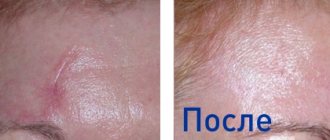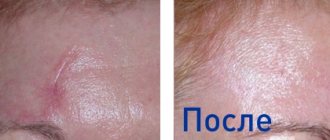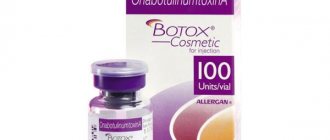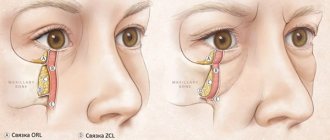Unlike all other scars, which complicate life only from an aesthetic point of view, keloid disease can be extremely painful. Burning, itching, tingling are typical symptoms of a keloid.
However, the unpleasant features do not end there. Keloids are the only type of scar that constantly grows. This is especially noticeable in the first months (and sometimes years) after the scar appears. Increasing in size, the keloid captures more and more areas of healthy tissue, and after some time the area of the scar can already be several times greater than the area of the original wound surface. So you shouldn’t delay seeing a doctor.
Laser resurfacing of post-acne scars.
When should you see a doctor?
Option 1.
If you already know that you have a tendency to form keloids, then the sooner the better.
Option 2.
Before any elective surgery. Contact a specialist before it is performed. To avoid keloid scars after surgery, your doctor will develop a series of measures to boost your immunity. It will eliminate the lack of essential vitamins and microelements. High-quality prevention in this case will bring more benefits than the most effective treatment.
Option 3.
If you have not suffered from keloid disease before, but after an injury or surgery, the scar behaves unusually. The following symptoms should be especially alarming: after two months, pain, itching or tingling persist in the scar, the scar rises more than 1-2 mm above the skin, does not decrease or even grows, has a bright red or bluish color and a shiny surface. Any of these signs indicate that we are most likely dealing with a keloid.
How to treat keloid scars during the growth stage
Keloid scars go through two stages in their development. At the stage of a young keloid, the scar is constantly growing. Therefore, the main goal of this stage of treatment is to stop the growth of the keloid and relieve the pain that arises from it.
The best effect at the growth stage is provided by hormonal therapy, in which the corticosteroids Diprospan or Kenalog - 40 are injected directly into the scar tissue.
Expert comment:
“To completely eliminate side effects and the influence of hormones on the body, the administration of corticosteroids must be carried out exactly according to the schedule. Firstly, the drug is diluted taking into account the patient's weight. Secondly, injections are carried out strictly once every 4 weeks, carefully inside the scar.
As practice shows, treatment of keloids can last many months. Therefore, even before starting treatment, you need to prepare yourself in advance for long-term results, carefully follow all the doctor’s recommendations, and be patient with a fairly large number of restrictions.
In particular, with keloids, direct sun, sauna, and solarium are prohibited. To improve immunity and eliminate the causes of keloids, you may need to completely reconsider your habits and give up some in favor of a healthy lifestyle.
Treatment of keloid fully corresponds to the well-known saying: between the doctor and the disease, the one on whose side the patient is on will win.”
Maxim Vasiliev, plastic surgeon.
Radiation bukki therapy - irradiation of the scar with gamma rays - also gives a good effect.
At the same time, in order to make the scar less noticeable, soften it and alleviate painful symptoms, it is recommended to use ointments and gels such as Naftaderm, Dimexide, Scarguard and ScarCare.
A silicone patch (for example, the Mepiform adhesive plaster) also works well at the first stage of treatment. The patch has a double effect. On the one hand, it softens the scar and reduces pain. On the other hand, it has a positive pressing effect, promoting the formation of a flat scar.
Contrary to popular belief, treatment of keloid scars with laser, excision or cauterization at this stage is impossible - the risk of provoking further uncontrolled growth of the keloid is almost 100%.
The goal of the first stage of treatment is to align the keloid scar with the level of the skin, make it pale and get rid of pain. If these goals are achieved, it is advisable to complete the treatment.
Diprospan
International name: Betamethasone
Group affiliation: Glucocorticosteroid
Description of the active substance (INN): Betamethasone
Dosage form: solution for injection, suspension for injection
Pharmacological action: GCS inhibits the release of interleukin1, interleukin2, interferon gamma from lymphocytes and macrophages. It has anti-inflammatory, antiallergic, desensitizing, antishock, antitoxic and immunosuppressive effects. Suppresses the release of ACTH and beta-lipotropin by the pituitary gland, but does not reduce the level of circulating beta-endorphin. Inhibits the secretion of TSH and FSH. Increases the excitability of the central nervous system, reduces the number of lymphocytes and eosinophils, increases the number of red blood cells (stimulates the production of erythropoietin). Interacts with specific cytoplasmic receptors and forms a complex that penetrates the cell nucleus and stimulates the synthesis of mRNA; the latter induces the formation of proteins, incl. lipocortin, mediating cellular effects. Lipocortin inhibits phospholipase A2, suppresses the release of arachidonic acid and suppresses the synthesis of endoperoxides, Pg, leukotrienes, which contribute to inflammation, allergies, etc. Protein metabolism: reduces the amount of protein in plasma (due to globulins) with an increase in the albumin/globulin ratio, increases the synthesis of albumins in liver and kidneys; enhances protein catabolism in muscle tissue. Lipid metabolism: increases the synthesis of higher fatty acids and TG, redistributes fat (fat accumulation mainly in the shoulder girdle, face, abdomen), leads to the development of hypercholesterolemia. Carbohydrate metabolism: increases the absorption of carbohydrates from the gastrointestinal tract; increases the activity of glucose-6-phosphatase, leading to an increase in the flow of glucose from the liver into the blood; increases the activity of phosphoenolpyruvate carboxylase and the synthesis of aminotransferases, leading to the activation of gluconeogenesis. Water-electrolyte metabolism: retains Na+ and water in the body, stimulates the excretion of K+ (MCS activity), reduces the absorption of Ca2+ from the gastrointestinal tract, “washes out” Ca2+ from the bones, increases the excretion of Ca2+ by the kidneys. The anti-inflammatory effect is associated with inhibition of the release of inflammatory mediators by eosinophils; inducing the formation of lipocortin and reducing the number of mast cells that produce hyaluronic acid; with a decrease in capillary permeability; stabilization of cell membranes and organelle membranes (especially lysosomal ones). The antiallergic effect develops as a result of suppression of the synthesis and secretion of allergy mediators, inhibition of the release of histamine and other biologically active substances from sensitized mast cells and basophils, T- and B-lymphocytes, mast cells, decreased sensitivity of effector cells to allergy mediators, inhibition of antibody formation, changes the body's immune response. In COPD, the action is based mainly on inhibition of inflammatory processes, inhibition of development or prevention of swelling of the mucous membranes, inhibition of eosinophilic infiltration of the submucosal layer of the bronchial epithelium, deposition of circulating immune complexes in the bronchial mucosa, as well as inhibition of erosion and desquamation of the mucous membrane. Increases the sensitivity of beta-adrenergic receptors of small and medium-caliber bronchi to endogenous catecholamines and exogenous sympathomimetics, reduces the viscosity of mucus by inhibiting or reducing its production. Antishock and antitoxic effects are associated with an increase in blood pressure (due to an increase in the concentration of circulating catecholamines and restoration of the sensitivity of adrenergic receptors to them, as well as vasoconstriction), a decrease in the permeability of the vascular wall, membrane protective properties, and activation of liver enzymes involved in the metabolism of endo- and xenobiotics. The immunosuppressive effect is due to inhibition of the release of cytokines (interleukin1, interleukin2; interferon gamma) from lymphocytes and macrophages. Suppresses the synthesis and secretion of ACTH and, secondarily, the synthesis of endogenous corticosteroids. Inhibits connective tissue reactions during the inflammatory process and reduces the possibility of scar tissue formation. Betamethasone disodium phosphate is a readily soluble compound that is well absorbed after parenteral administration into tissues and provides a rapid effect. Betamethasone dipropionate has a slower absorption. By combining these salts it is possible to create drugs with both short-term (but rapid) and long-term effects. Depending on the method of application (IV, IM, intra-articular, periarticular, IV), a general or local effect is achieved.
Indications: Shock (burn, traumatic, surgical, toxic, cardiogenic) when other therapy is ineffective. Allergic reactions (acute, severe forms), blood transfusion shock, anaphylactic shock, anaphylactoid reactions. Brain swelling (including due to a brain tumor or associated with surgery, radiation therapy or head trauma). Bronchial asthma (severe form), status asthmaticus. Systemic connective tissue diseases (SLE, rheumatoid arthritis). Acute adrenal insufficiency. Thyrotoxic crisis. Acute hepatitis, hepatic coma. Poisoning with cauterizing liquids (reducing inflammation and preventing cicatricial contractions).
Contraindications: For parenteral administration for short-term use for “vital” indications, the only contraindication is hypersensitivity. For intra-articular administration: previous arthroplasty, pathological bleeding (endogenous or caused by the use of anticoagulants), intra-articular bone fracture, infectious (septic) inflammatory process in the joint and periarticular infections (including a history), as well as a general infectious disease expressed periarticular osteoporosis, absence of signs of inflammation in the joint (the so-called “dry” joint, for example, in osteoarthritis without synovitis), severe bone destruction and joint deformation (sharp narrowing of the joint space, ankylosis), joint instability as a result of arthritis, aseptic necrosis of the epiphyses forming the joint bones. With caution. Parasitic and infectious diseases of a viral, fungal or bacterial nature (currently or recently suffered, including recent contact with a patient) - herpes simplex, herpes zoster (viremic phase), chicken pox, measles; amebiasis, strongyloidiasis (established or suspected); systemic mycosis; active and latent tuberculosis. Use for severe infectious diseases is permissible only against the background of specific therapy. Post-vaccination period (a period of 8 weeks before and 2 weeks after vaccination), lymphadenitis after BCG vaccination. Immunodeficiency conditions (including AIDS or HIV infection). Gastrointestinal diseases - gastric and duodenal ulcers, esophagitis, gastritis, acute or latent peptic ulcers, recently created intestinal anastomosis, ulcerative colitis with the threat of perforation or abscess formation, diverticulitis. Diseases of the cardiovascular system, incl. recent myocardial infarction (in patients with acute and subacute myocardial infarction, the necrosis focus may spread, the formation of scar tissue may slow down and, as a result, the heart muscle will rupture), decompensated CHF, arterial hypertension, hyperlipidemia). Endocrine diseases - diabetes mellitus (including impaired carbohydrate tolerance), thyrotoxicosis, hypothyroidism, Itsenko-Cushing's disease. Severe chronic renal and/or liver failure, nephrourolithiasis. Hypoalbuminemia and conditions predisposing to its occurrence. Systemic osteoporosis, myasthenia gravis, acute psychosis, obesity (III-IV stage), poliomyelitis (except for the form of bulbar encephalitis), open- and closed-angle glaucoma, pregnancy, lactation. For intra-articular administration: the general serious condition of the patient, the ineffectiveness (or short duration) of the action of 2 previous injections (taking into account the individual properties of the GCS used).
Side effects: The incidence and severity of side effects depend on the duration of use, the size of the dose used and the ability to comply with the circadian rhythm of the prescription. From the endocrine system: decreased glucose tolerance, “steroid” diabetes mellitus or manifestation of latent diabetes mellitus, suppression of adrenal function, Itsenko-Cushing syndrome (moon-shaped face, pituitary-type obesity, hirsutism, increased blood pressure, dysmenorrhea, amenorrhea, myasthenia, stretch marks) , delayed sexual development in children. From the digestive system: nausea, vomiting, pancreatitis, “steroid” gastric and duodenal ulcers, erosive esophagitis, bleeding and perforation of the gastrointestinal tract, increased or decreased appetite, flatulence, hiccups. In rare cases, there is an increase in the activity of liver transaminases and alkaline phosphatase. From the cardiovascular system: arrhythmias, bradycardia (up to cardiac arrest); development (in predisposed patients) or increased severity of CHF, ECG changes characteristic of hypokalemia, increased blood pressure, hypercoagulation, thrombosis. In patients with acute and subacute myocardial infarction - the spread of necrosis, slowing down the formation of scar tissue, which can lead to rupture of the heart muscle. From the nervous system: delirium, disorientation, euphoria, hallucinations, manic-depressive psychosis, depression, paranoia, increased intracranial pressure, nervousness or anxiety, insomnia, dizziness, vertigo, pseudotumor of the cerebellum, headache, convulsions. From the senses: sudden loss of vision (with parenteral administration in the head, neck, nasal turbinates, scalp, deposition of drug crystals in the vessels of the eye is possible), posterior subcapsular cataract, increased intraocular pressure with possible damage to the optic nerve, tendency to develop secondary bacterial , fungal or viral eye infections, trophic changes in the cornea, exophthalmos. From the metabolic side: increased excretion of Ca2+, hypocalcemia, increased body weight, negative nitrogen balance (increased protein breakdown), increased sweating. Caused by MCS activity - fluid and Na+ retention (peripheral edema), hypernatremia, hypokalemic syndrome (hypokalemia, arrhythmia, myalgia or muscle spasm, unusual weakness and fatigue). From the musculoskeletal system: slowing of growth and ossification processes in children (premature closure of the epiphyseal growth zones), osteoporosis (very rarely - pathological bone fractures, aseptic necrosis of the head of the humerus and femur), rupture of muscle tendons, “steroid” myopathy, decreased muscle mass (atrophy). From the skin and mucous membranes: delayed wound healing, petechiae, ecchymosis, thinning of the skin, hyper- or hypopigmentation, steroid acne, stretch marks, tendency to develop pyoderma and candidiasis. Allergic reactions: generalized (skin rash, skin itching, anaphylactic shock), local allergic reactions. Other: development or exacerbation of infections (the appearance of this side effect is facilitated by jointly used immunosuppressants and vaccination), leukocyturia, flushing syndrome, convulsions. With intracranial administration - nosebleeds. When administered intra-articularly - increased pain in the joint. Overdose. Symptoms: nausea, vomiting, sleep disorders, euphoria, agitation, depression. With long-term use in high doses - osteoporosis, fluid retention in the body, increased blood pressure and other signs of hypercortisolism, including Itsenko-Cushing syndrome, secondary adrenal insufficiency. Treatment: against the background of gradual drug withdrawal, maintenance of vital functions, correction of electrolyte balance, antacids, phenothiazines, Li+ preparations; for Itsenko-Cushing syndrome - aminoglutethimide.
Method of administration and dosage: The method of administration and dosage regimen depend on the severity and nature of the disease. Betamethasone disodium phosphate - IV stream (slowly) or drip, single dose - 4-8 mg (1-2 ml), if necessary - up to 20 mg; maintenance dose - 2-4 mg. The infusion solution is diluted in 0.9% NaCl solution or dextrose solution. Prepare immediately before use. Unused solutions are stored in the refrigerator for no more than 24 hours. Betamethasone dipropionate - deep intramuscularly, at an initial dose of 4-8 mg for severe diseases (SLE, status asthmaticus). For children aged 1 to 5 years, the initial dose is 2 mg, for children 6-12 years old - 4 mg. For the prevention of hyaline-membranous disease of newborns during premature birth - IM, 8 mg 48-72 hours before birth (at least 24 hours), the injection is repeated after 24 hours. Intra-articular and periarticular: very large joints (pelvic) - 4 -8 mg, large joints (knee, ankle, shoulder) - 4 mg, medium joints (elbow, wrist) - 2-4 mg, small joints (interphalangeal, sternoclavicular, metacarpophalangeal) - 1-2 mg (0.25-0.5 ml). IV or intrawound administration for the treatment of skin diseases - 0.2 ml/sq.cm, but not more than 4 mg/week. Local infiltration: for bursitis - 1-2 mg (for acute form up to 8 mg), for synovial cyst and synovitis - 1-2 mg, for tendonitis - 2 mg, for myositis, fibrositis, peritendinitis, periarticular inflammation - 2-4 mg ; administration is repeated every 1-2 weeks. If necessary, 2 mg is administered subconjunctivally.
Special instructions : Mixing with an equal volume of solutions of local anesthetics (1% solution of procaine hydrochloride or 1% solution of lidocaine hydrochloride) in a syringe (but not in an ampoule) is allowed. Do not use for the treatment of hyaline membrane disease of newborns, inject into unstable joints, infected areas and intervertebral spaces. Before and during steroid therapy, it is necessary to monitor a general blood count, glycemia and glucosuria, and plasma electrolyte levels. When treating during intercurrent infections, septic conditions, tuberculosis, antibiotic treatment is carried out simultaneously. Children who during the treatment period were in contact with patients with measles or chickenpox are prescribed specific Ig prophylactically. During pregnancy and lactation, it is prescribed taking into account the expected therapeutic effect and negative effect on the fetus. In children during the growth period, GCS should be used only according to absolute indications and under the particularly careful supervision of the attending physician. It must be taken into account that in patients with hypothyroidism the clearance of GCS is reduced, and in patients with thyrotoxicosis it is increased.
Interaction: Reduces the effectiveness of insulin, oral hypoglycemic and antihypertensive drugs, anticoagulants (coumarin and indandione derivatives, heparin, streptokinase and urokinase); weakens the effect of diuretics, the activity of vaccines (due to decreased antibody production); reduces the content of salicylates in the blood; reduces the concentration of praziquantel in the blood serum. Rifampicin, phenytoin, barbiturates weaken the effect (being inducers of “liver” microsomal enzymes, they increase the metabolic rate); hormonal contraceptives increase effectiveness. Increase the risk of side effects: NSAIDs and ethanol (erosive and ulcerative lesions and bleeding from the gastrointestinal tract); androgens, estrogens, oral contraceptives, anabolic steroids (hirsutism, acne); antipsychotic drugs, immunosuppressants (increasing the likelihood of developing infections, as well as lymphomas and other lymphoproliferative diseases), bucarban, azathioprine (cataracts); m-anticholinergics, antihistamines, tricyclic antidepressants, nitrates (increased intraocular pressure); diuretics (hypokalemia), digitalis glycosides (arrhythmias associated with hypokalemia), ritodrine (possibility of developing pulmonary edema in pregnant women). Increases the risk of hepatotoxicity of paracetamol. Amphotericin B and carbonic anhydrase inhibitors increase the risk of osteoporosis. Increases the toxicity of asparaginase (possibly increasing its hypoglycemic effect and the risk of developing neuropathy and impaired erythropoiesis). Reduces the metabolism of cyclosporine, increases its toxicity. Increases (with long-term therapy) the content of folic acid. Increases the metabolism of isoniazid, mexiletine (especially in “fast acetylators”), which leads to a decrease in their plasma concentrations. Mitotane and other inhibitors of adrenal cortex function may necessitate an increase in the dose of GCS. Hypokalemia caused by GCS can increase the severity and duration of muscle blockade due to muscle relaxants. Accelerates the elimination of ASA, reduces its level in the blood (when betamethasone is discontinued, the concentration of salicylates in the blood increases and the risk of side effects increases). Reduces the effect of somatropin. Increases the severity of the hyperglycemic effect of streptozocin. When used simultaneously with live antiviral vaccines and against the background of other types of immunization, it increases the risk of viral activation and the development of infections.










